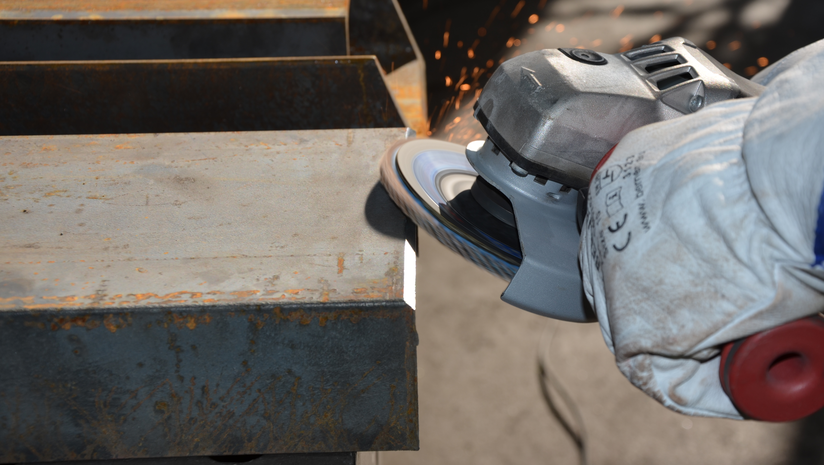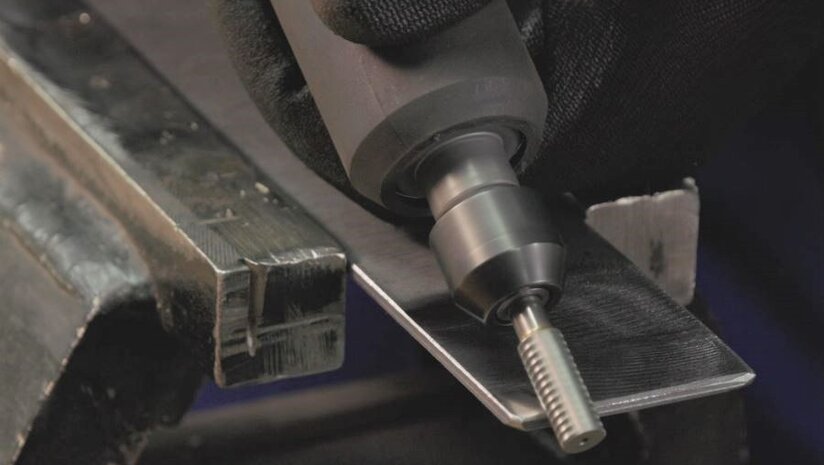
Beveling
If two workpieces are to be welded together, the edge of the workpieces must first be broken by a beveled surface. This is done by machining. The result is a chamfer, also known as a bevel.
What is beveling and
why is it important?
If two workpieces are to be welded together, the edge of the workpieces must first be broken by a beveled surface. This is done by machining. Or in other words, a space is created to accommodate the individual welding layers through which the workpieces are joined together. The bevel can have different shapes. The V-joint, the double V-joint, and the Y-joint are the most common shapes.
Which tool is used for beveling?
The position of the weld, the material of the workpiece, and the types of drives available - the choice of the right tool depends on various factors.
If an angle grinder is available, the beveling can be done with sulfur- and iron-free Osborn flap discs. Flap discs with a conical or straight shape are available. The angle on the workpiece determines the shape of the flap wheel.
If a workpiece made of non-ferrous metal is to be beveled, we recommend an abrasive cloth with a cooling bond as it reduces blue tarnish.

Pictured: Beveling with an Osborn flap disc.
If a straight grinder or air grinder is available, chamfering can be done with carbide burrs. The milling head is made of tungsten carbide-cobalt, the shank of tool steel. Different head shapes and toothings ensure that there is the right solution for every application.
For chamfering, burrs with cross serration (Z6) are the best choice. It ensures high stock removal in a short time. If the surface quality is important, a single tooth (Z3) is recommended. In the shipyard sector, the special shipyard toothing is often used. Compared to the Z6 toothing, it has a 30% higher material removal rate.

Camfering with a carbide burr.
Products for
Beveling.

Airway Cotton Buff
Made from the tightest quality cloth specifications, these cloth buffs set the industry standard for quality and performance. The standard ventilated buff is suitable for almost every step in the polishing process. This buff runs cooler than stitched buffs, is more flexible and does a better job on contour work. The irregular folds fixed to a metal clinch ring form a flexible and economical buff.

Airway Mill Treated Cotton Buff
This type of buff is constructed using the highest quality material and is biased to reduce fraying and increase life. This makes them effective finishing tools for ferrous & non-ferrous metals, marble, plastics, and other materials. Mill treated buffs offer a firmer hand and can provide a one step cut and color process.

Conventional Cotton Buff
These buffs are made with 100% cotton. Loose full disc buffs are made with 1 row of sewing around the arbor hole. They are soft and flexible and are ideal for reaching uneven surfaces while buffing or coloring metals, hard rubber, marble and plastics. Spiral and concentric sewn buffs are harder than loose buffs.

Yellow Bar Cut/Color Compound
A full range of solid polishing compounds that can be used individually or in combination to achieve a desired result. All compounds are supplied in many variations and sizes for manual and robotic operations. There is no one size fits all, Osborn prides itself on recommending the best, most efficient solution for every application.

Ringlock Wire Wheel Brush
Specially designed to brush down-hole, internal surfaces and other hard-to-reach areas. Designed with Osborn’s proprietary TufWire™ wire strands to provide effective brushing, this product can be mounted singly or in multiples, directly onto the shaft of a portable tool to accommodate a wide variety of tasks.

Small Diameter Nylon Wheel Brush
Osborn’s Small Diameter Nylon Wheel Brush features durable synthetic filaments that are tough enough to remove burrs, scale, rust, carbon, corrosion, and plastic flash. Flexible, non-metallic fill material makes it an ideal choice for materials that would typically be damaged by wire brushes. Made in the USA.

ATB Ringlock™ Brush
Constructed with high-quality nylon filament with choice of Silicon Carbide or Ceramic abrasive, Osborn’s small diameter ATB Ringlock™ Wheel Brushes are ideal for a variety of tasks using portable tools and drill presses. Silicon Carbide brushes tackle a variety of cleaning and deburring both ID and OD surfaces while Ceramic brushes are designed for more aggressive deburring applications. Brushes are expertly designed and tested to provide unmatched longevity.

Sibot Internal Finishing Brush
This hard-working square-trimmed brush features rugged crimped steel wire to efficiently brush both the bottom and sides of a hole in a single operation. Provides quick, uniform cleaning of internal surfaces, and can be used in drill presses and portable tools. Ideal for removing fine burrs from the edges of cross-drilled holes and spot facing.

Small Diameter TY™ Encapsulated Wheel Brush - Standard Duty
The power and premium quality of an Osborn TY™ Encapsulated Wheel Brush sized down to fit hand-held air and electric tools such as pencil grinders. Ideal for confined areas, flash/rust removal, and aggressive deburring in tight spots. Made in the USA.

Crimped Wire Narrow Face Wheel Brush
Designed to clean and deburr the narrowest of areas, Osborn Crimped Wire Narrow Face Wheel Brushes offer a flexible solution for a variety of spaces. These brushes can also be mounted in multiples to tackle wider surfaces to remove paint or produce antique finishes. All varieties feature Osborn’s proprietary TufWire™ to ensure uniform performance and extended lifespan. Note that all 3/8”-5/8” and ½”-5/8” arbor holes are supplied with a removable adapter.

Crimped Wire Spiral Tube Brush - Single Stem, Single Spiral
This small diameter crimped wire brush is designed to tackle a wide variety of internal cleaning jobs. Available with choice of steel or stainless steel filament for use on hand tools, drill presses and power tools, Osborn Wire Spiral Tube Brushes are designed for optimal performance and longevity.